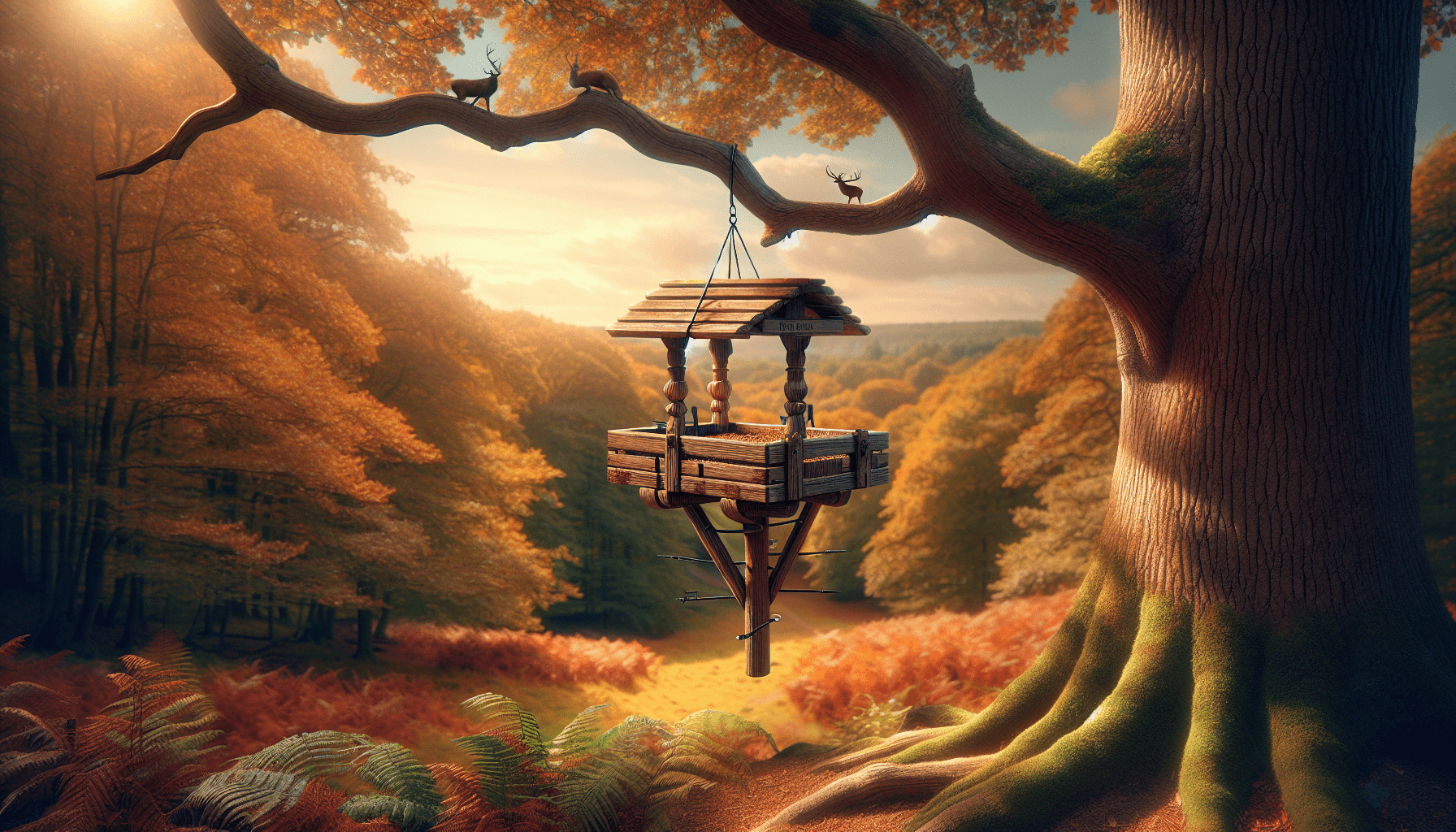
Have you ever faced issues with your hanging deer feeders, leaving you scratching your head, wondering where you went wrong? It’s a common scenario for many who enjoy the benefits of feeding and attracting deer to their property. Despite the numerous advantages of using hanging deer feeders, they aren’t without their challenges. Knowing how to troubleshoot these common problems can make your experience far more rewarding.
Understanding Hanging Deer Feeders
Before diving into troubleshooting, it’s valuable to understand how these devices work and why they are beneficial. Hanging deer feeders, such as those from Moultrie or Gravity Fed, are designed to dispense feed at intervals or when deer interact with them. These feeders are particularly useful for hunters and wildlife enthusiasts, providing a controlled way to attract and nurture deer populations.
Benefits of Hanging Deer Feeders
Utilizing hanging deer feeders has multiple advantages:
- Controlled Feeding: You can manage how much feed is dispensed, ensuring it lasts longer and feeds more deer.
- Reduced Waste: Hanging feeders minimize spillage and waste compared to ground feeders.
- Predator Prevention: Elevated feeders keep food out of reach of non-target animals like raccoons or bears.
- Health Monitoring: Regular visits to feeders allow you to monitor the health and population size of local deer.
Popular Brands and Models
There are numerous brands and models available in the market, each offering unique features:
| Brand | Models |
|---|---|
| Moultrie | AAA GameFeeder, 6.5-Gallon Directional Feeder, etc. |
| American Hunter | Sun Slinger, 225-lb Digital Feeder, etc. |
| WILDGAME INNOVATIONS | Quick Set 270, Moonshine Lightening Feeder, etc. |
| On Time Wildlife Feeders | Elite Lifetime Feeder, Tomahawk Feeder, etc. |
| Boss Buck | Simple Set Feeder, Gravity Fed Feeder, etc. |
Recognizing these products will help you understand the feeder you’re operating, as specifications and functionalities can vary widely.
Common Issues with Hanging Deer Feeders
Even with the best models, issues can arise. Knowing common problems and their solutions can save you time and frustration.
Jammed or Clogged Feed Dispenser
One of the most frequent issues is a jammed dispenser. This can happen for several reasons:
- Wet Feed: Moisture can cause feed to clump together, blocking the feeder’s mechanism.
- Wrong Type of Feed: Some feeds are not suited for specific feeders. Check the manufacturer’s recommendation.
- Obstruction: Debris or pests might obstruct the feeder’s dispenser.
Solution
- Regular Cleaning: Clean your feeder regularly to remove old feed and prevent build-up.
- Weatherproof Feed: Store your feed in a dry location and use weatherproof containers like those from SolutionsPatIQ.
- Inspect and Clear Obstructions: Regularly check for and remove any blockages.
Battery or Power Supply Issues
Many hanging feeders, such as those from KUMFJ, are battery-powered. A dead or malfunctioning battery can halt operations.
Solution
- Regular Battery Replacement: Replace batteries on a set schedule, ideally before they run out of juice.
- Solar Panels: Consider solar-powered options or accessory kits to extend battery life.
Incorrect Timer Settings
Sometimes, the problem can be as simple as incorrect timer settings causing your feeder to dispense feed at the wrong times or not at all.
Solution
- Read the Manual: Always refer to the user manual for guidelines on setting the timer correctly.
- Test Runs: Perform test runs to ensure the timer dispenses feed at the desired times.
Animal Damage
Apart from deer, other animals might try to access the feed, causing damage to your feeder. This is notably common with brands like Highwild that are designed to deter smaller animals.
Solution
- Durable Materials: Choose feeders made from durable materials to withstand attempts from other animals.
- Additional Barriers: Consider adding barriers or baffles to prevent non-target animals from reaching the feed.
Wind and Weather
Extreme weather conditions, like wind or heavy rain, can impact the distribution of feed and even damage the feeder itself.
Solution
- Location: Place your feeder in a sheltered location to minimize exposure to extreme weather.
- Protective Covers: Use protective covers designed for your specific feeder model.
Mechanical Failures
Mechanical parts can fail over time, affecting the performance of your hanging deer feeder.
Solution
- Routine Maintenance: Conduct routine inspections to identify wear and tear early.
- Warranty and Repairs: Make use of warranties and contact customer support for necessary repairs.

Finder and Fixer Chart
Here’s a quick chart to help you identify and solve common issues with your hanging deer feeder:
| Issue | Possible Causes | Solutions |
|---|---|---|
| Jammed Dispenser | Wet feed, wrong type of feed, obstructions | Regular cleaning, weatherproof feed, clear obstructions |
| Battery Issues | Dead/malfunctioning battery | Regular battery replacement, use solar panels |
| Incorrect Timer Settings | Misconfigured timer | Refer to the manual, perform test runs |
| Animal Damage | Other animals accessing feed | Use durable materials, add barriers |
| Weather Impact | Exposure to extreme weather | Place in sheltered location, use protective covers |
| Mechanical Failures | Wear and tear on parts | Routine maintenance, utilize warranties |
Practical Tips for Maintenance
Proper maintenance is key to ensuring your feeder remains in optimal working condition.
Cleaning Your Feeder
Regular cleaning prevents feed build-up and potential clogs. Here’s a simple cleaning routine:
- Empty the Feeder: Remove all feed to start with an empty feeder.
- Disassemble: Take apart removable components according to the manufacturer’s instructions.
- Clean: Use a brush and soapy water to clean each part thoroughly.
- Dry: Ensure all parts are fully dry before reassembling to prevent moisture-related issues.
- Check and Refill: After reassembling, refill with fresh, dry feed.
Scheduling Battery Replacement
To avoid unexpected downtimes, here are some tips for managing batteries:
- Set a Schedule: Place reminders in your calendar to change batteries, ideally every 4-6 months.
- Carry Spares: Always have a spare set of batteries handy, just in case.
- Monitor Battery Life: Some feeders have indicators showing remaining battery life. Pay attention to these alerts.
Timer Calibration
Ensure the timer on your feeder is properly set:
- Seasonal Adjustments: Adjust the timer settings based on changes in deer activity throughout the seasons.
- Test It Out: Run tests after each adjustment to verify the correct amount and timing of feed distribution.
Animal Deterrents
To protect your feeder from unwanted animals:
- Feeder Height: Hang your feeder at least 8-10 feet high to keep it out of reach of most non-target animals.
- Use Spinners: Attach spinners or other deterrents that rotate or move to scare off smaller animals.
- Secure Feeders: Use heavy-duty hooks and chains that can withstand forceful tampering.

Choosing the Right Feed
Your feeder is only as good as the feed you put in it. Selecting the appropriate feed is crucial.
Types of Feed
There are different types of feed suitable for deer:
- Pellets: Compact and easy to handle, pellets reduce the chances of clumping and jamming.
- Grain: Corn is a popular choice, but ensure it’s compatible with your feeder model.
- Nutritionally Balanced Feed: Formulated feeds, often provided by brands like Andee, offer complete nutrition to support deer health.
Avoiding Feed Spoilage
Proper storage and handling can prevent feed spoilage:
- Store in Airtight Containers: Prevent moisture and pests from contaminating your feed.
- Use Fresh Feed: Rotate stock regularly to ensure the freshest feed is always dispensed.
- Check Expiry Dates: Pay attention to expiry dates and avoid using expired feed.
Knowing When to Upgrade or Replace Your Feeder
Sometimes, no matter how well you maintain your feeder, age and heavy use can take their toll. Knowing when to upgrade or replace your feeder is essential.
Indicators for Replacement
Consider replacement if your feeder shows the following signs:
- Extensive Wear and Tear: When repairs are more frequent and less effective.
- Persistent Operational Issues: Continual clogs, inconsistent feeding, or repetitive mechanical failures.
- Outdated Technology: If your current model lacks features like solar charging or advanced timers found in modern feeders from brands like On Time Wildlife Feeders.
Choosing a New Model
Select a new model based on these factors:
- Feed Capacity: Choose the right capacity for your feeding needs. Models from brands like Boss Buck offer various sizes.
- Durability: Look for high-quality materials that can withstand weather and animal interference.
- Advanced Features: Modern features like solar power options, digital timers, and weatherproof designs enhance feeding efficiency.
Conclusion
Troubleshooting common issues with hanging deer feeders is no small feat, but with the right knowledge and proactive maintenance, you can ensure your feeder operates smoothly. Keep your equipment in top shape and enjoy the benefits of maintaining a healthy, thriving deer population on your property. If you continually face problems despite troubleshooting, it might be time to invest in a new model packed with advanced features to simplify your deer feeding endeavors.



